It was very difficult for Stalin tossed either to Japan or China the lands in which he had invested so much effort, time, and money. He especially could not afford to lose Mongolia to Chiang Kai-shek’s China, which had become an enemy right after the end of the war. outer Mongolia was indeed a reliable buffer zone for the Soviet Union, a fact which would be strikingly illustrated over the next 30 years.
The Soviet Union Officially Recognizes the MPR
Stalin was well aware that the United States, a new benefactor with whom Chiang Kaishek had lately been flirting, would not only become a rival but also a future enemy of the Soviets. Stalin had already made up his mind to take a hostile stance toward the democratic regimes in the West. In doing so, he naturally needed a buffer zone. But in the 1940s China’s relationship with the triumphant allies remained fairy good. Since Japanese influence was waning, China would surely demand back Outer Mongolia, for they already had de jure sovereignty there. The Chinese had made this demand in Cairo. The only feasible solution to this mess was to give independence to Outer Mongolia. And so, during a meeting in Moscow with Hopkins, Stalin asked the United States to recognize the Mongolian People’s Republic. The Americans, who now had a good understanding of Outer Mongolia, were happy to do this.
Based upon the returns of the independence referendum, which was held on October 220, 1945, the Executive Yuan of China officially recognized the MPR on January 6, 1946. On February 27, a Twenty-Year Treaty of Friendship and Cooperation was concluded between Mongolia and the Soviet Union, which meant that the Soviet Union officially recognized the MPR for the first time. From this day, the Russian mission in Ulaanbaatar was made an Embassy and the so-called Polpred, or Plenipotentiary Representative, was replaced by an Ambassador Extraordinary and Plenipotentiary. By 1950 other communist countries such as North Korea, North Vietnam, Poland, Czechoslovakia, Hungary, and Romania recognized the new Mongolian People’s Republic and established diplomatic relations. The Chinese Communists, under Chairman Mao, who came to power in 1949 after overthrowing Chiang Kaishek, immediately recognized the independence of Mongolia and opened an embassy in Ulaanbaatar. In this way, the two hundred and fifty-year dream of the Mongols, and the efforts of the Halha hutagts and nobles began thirty-five years before, finally fulfilled. An independent and internationally recognized Mongolia was formed. Thee principles of Westphalia became a reality in Mongolia. Mongolia became a nation-state.
The Destiny of the Mongols
Although the Chinese from Yuan Shikai to Deng Xiaoping have considered Outer Mongolia part of their lost territory, the Mongols, like all other nations, have a right to independence. The history of both Mongolia and China goes beyond the past two thousand years. The Mongols and the Chinese are two of the oldest nations in the world. While so-existing for many centuries, the two nations were independent of each other and often hostile toward each other. Several times the Chinese were subject to the nomads, as a result of the aggression and invasion by the northern nomadic tribes. The main slogan of the Xinhai Revolution in China was “Drive out the northern Manchu, overthrow the Qing Dynasty and revive our own Ming Dynasty”.
Historical documents show that the two northern nomadic nations, the Manchu and the Mongols, had signed a vassal treaty was abrogated in 1907, giving Mongolia the right ot self-determination.

